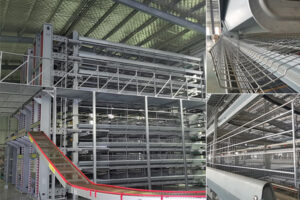Battery layer cages are an essential part of poultry farming, providing a structured and efficient environment for laying hens. Understanding the pricing of these cages is crucial for anyone looking to invest in or upgrade their poultry farming operations.
Understanding Battery Layer Cages
Types of Battery Layer Cages
Battery layer cages come in different types and configurations, each designed to meet specific needs of poultry farmers. The two main types are:
-
A-Type Battery Cages: These are traditional layer cages arranged in an A-frame structure. They are widely used due to their simplicity and cost-effectiveness. A-Type cages generally accommodate fewer birds per unit but are easier to manage and maintain.
-
H-Type Battery Cages: These cages are designed in a vertical arrangement, allowing for higher density stocking. H-Type cages are more sophisticated, offering automated feeding, watering, and egg collection systems. They are suitable for large-scale operations but come at a higher initial cost.

Materials Used
The material used in constructing battery layer cages significantly affects their price. Common materials include:
-
Galvanized Steel: This is the most common material due to its durability and resistance to rust and corrosion. Galvanized steel cages tend to be more expensive but offer a longer lifespan.
-
PVC Coated Wire: Some cages use PVC coated wire for additional protection against corrosion. These cages are generally cheaper but may not last as long as galvanized steel cages.
-
Plastic: Although less common, some cages are made from high-strength plastic. These are lightweight and easy to clean but may not be as durable as metal cages.
Factors Influencing the Price for Battery Layer Cages
Size and Capacity
The size and capacity of the cages directly impact their price. Larger cages that can accommodate more birds will naturally cost more. It’s essential to balance the initial investment with the operational efficiency and potential return on investment.
Automation Features
Modern battery layer cages often come with various automation features such as automatic feeding, watering, and egg collection systems. These features enhance efficiency and reduce labor costs but increase the initial purchase price. Farmers need to consider the long-term benefits of automation when evaluating the cost.
Brand and Manufacturer
The brand and manufacturer also play a significant role in pricing. Established brands with a reputation for quality and reliability tend to charge more for their products. However, these cages often come with better warranties and customer support, making them a worthwhile investment.
Market Conditions
Market conditions, including supply and demand, can influence the price for battery layer cages. Prices may vary depending on the season, economic factors, and changes in the poultry industry. It’s advisable to monitor market trends and make purchases when prices are favorable.

Where to Find Layer Cages for Sale
Finding high-quality layer cages is crucial for poultry farmers aiming to optimize their operations. One reputable source for these cages is LIVI Poultry Equipment Manufacture. Established in 1990, LIVI Poultry Equipment Manufacture has over 30 years of experience in manufacturing top-notch chicken farming equipment. Their products are well-received in various markets, including Kenya, due to their durability, efficiency, and affordability. Here’s a closer look at what LIVI Poultry Equipment Manufacture offers and other potential sources for layer cages.
LIVI Poultry Equipment Manufacture is a renowned name in the poultry farming industry. With a history spanning more than three decades, they specialize in producing a wide range of chicken farming equipment, including various types of layer cages. Their products are particularly popular in Kenya, thanks to their high quality and affordability.
Estimating the Cost for Your Farm
Initial Investment
The initial investment in battery layer cages varies based on the factors discussed earlier. On average, the cost of a single cage unit ranges from $100 to $150. For a 1,000-bird farm, you might need approximately 250 cage units, totaling an initial investment of $25,000 to $37,500. This estimate can vary based on the type of cage, material, and additional features.
Operating Costs
In addition to the initial investment, it’s essential to consider ongoing operating costs. These include maintenance, replacement parts, and utility costs associated with automated systems. Proper maintenance can extend the lifespan of the cages, reducing the need for frequent replacements.
Return on Investment
Investing in high-quality battery layer cages can significantly improve your farm’s productivity and profitability. Efficient cages reduce mortality rates, increase egg production, and lower labor costs. Calculating the return on investment involves comparing the initial and ongoing costs with the increased revenue from higher egg production.
Conclusion
Finding the right battery layer cages for your poultry farm involves considering various factors such as type, material, size, and additional features. Prices for battery layer cages can vary widely, but investing in quality cages can lead to substantial long-term benefits. By exploring different purchasing options and understanding the factors influencing prices, you can make an informed decision that enhances your farm’s efficiency and profitability.

